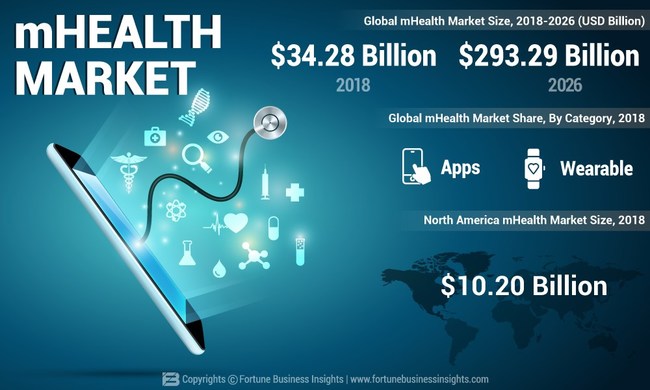SPONSOR: CardioComm Solutions (EKG: TSX-V) – The heartbeat of cardiovascular medicine and telemedicine. Patented systems enable medical professionals, patients, and other healthcare professionals, clinics, hospitals and call centres to access and manage patient information in a secure and reliable environment.

Mhealth Market to Reach USD 293.29 Billion by 2026; Increasing Smartphone Penetration to Contribute Healthy Growth, States Fortune
- The global mHealth market size is expected to reach USD 293.29 billion by 2026, exhibiting a CAGR of 29.1% during the forecast period.
- Increasing penetration of smartphones and smart devices will boost the mHealth market trends during the forecast period.
The increasing penetration of smartphones and smart devices will boost the mHealth market trends during the forecast period. According to Pew Research Center’s first survey of smartphone ownership conducted in 2011, 96% of Americans own a cell phone. Out of which ,81% of the American use smartphones. While roughly three-quarters of U.S. adults own desktop or laptop computers, furthermore, the launch of technologically advanced smartphones and wearable devices will consequently aid the mHealth market share, sates our lead analysts at Fortune Business Insights. For instance, OnePlus launched a new concept phone, the OnePlus Concept One McLaren Edition has various features including electrochromic glass technology. In addition, Fitbit CEO James said in a statement, “We see ourselves evenly split between being a consumer company and being a health company.”

mHealth Market Analysis, Insights and Forecast, 2015-2026
According to the report, published by Fortune Business Insights in a report, titled “mHealth Market Size, Share & Industry Analysis, By Category (By Apps {Disease & Treatment Management, Wellness Management}, By Wearable {Body & Temperature Monitors, Sleep Trackers, Fitness Trackers, Glucose Monitors, BP Monitors, Cardiac Monitors}) By Services Type (Monitoring Services, Fitness & Wellness Solutions, Diagnostic Services, Treatment Services) By Service Provider (mHealth App Companies, Pharmaceutical Companies, Hospitals, Health Insurance) and Regional Forecast, 2019-2026″ the market size stood at USD 34.28 billion in 2018. The mHealth market report implements a PESTEL study and SWOT analysis to reveal the stability, restrictions, openings, and threats in the smart building market. Combined with the market analysis proficiencies and data integration with the relevant findings, the report has foretold the robust future growth of the market, and all articulated with geographical and merchandise segments. Moreover, it also shows different procedures and strategies, benefactors and dealers working in the market, explores components convincing market development, generation patterns, and following systems. Additionally, the figures and topics covered in this report are both all-inclusive and reliable for the readers.
Growing Geriatric Population to Spur Business Opportunities for the Market
The increasing demand for mHealth solutions around the globe, owing to its user-friendly benefits and high calling efficiency in handling an emergency situation, will aid the mHealth market revenue in the forthcoming years. The increasing number of mHealth applications such as chronic disease management, remote monitoring owing to its cost-effective advantage will further fuel demand for mHealth solutions in the foreseeable future. The growing geriatric population will also contribute positively to the growth of the market. For instance, people above the age of 65, are more prone to chronic ailments; in the U.S., 40 million people, i.e., around 12.9% of the population is above 65 years. Thus, there is a colossal scope for the mHealth market in the countries where the geriatric population is surging.
Source: https://www.prnewswire.com/news-releases/mhealth-market-to-reach-usd-293-29-billion-by-2026-increasing-smartphone-penetration-to-contribute-healthy-growth-states-fortune-business-insights-300993421.html









